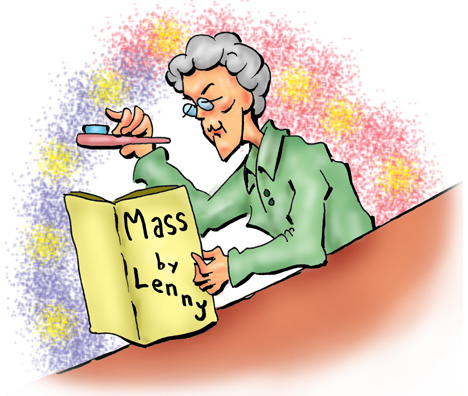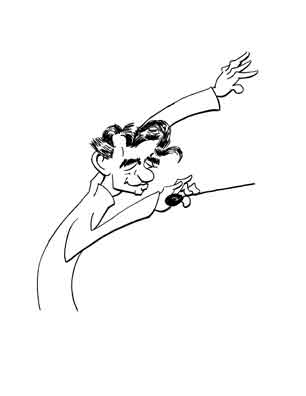Nadia Boulanger

Nadia Boulanger
She taught Lenny.
Encore une fois, the author and illustrator of CooperToons must respond to just criticism. But as he has before elaborated on said just criticism, he will say no more.
But you can say more about Nadia Boulanger. Madame Boulanger was one of the most famous musical pedagogues of the 20th century. She taught composition at the famed Conservatoire Américain au Palais de Fontainebleau. Amongst the students she taught were a couple of guys named Aaron Copeland and Leonard Bernstein.
And we wonder. Nadia was born in 1887 and lived until 1979. So we wonder if she heard Lenny's work of musical theater, Mass.

Leonard Bernstein
He learned from Nadia.
O rather, we should ask in the course of her long life did she ever expect one of her prized students - who never spoke of Nadia except with the highest praise - would write a - quote - "serious work" - unquote - featuring kazoos?
Nadia came from a musical family. Her dad, Ernest, was a singer, pianist, and conductor (he made international tours) and her mom, Raïssa (née Mycetsky) was a singer, and her dad was professor at the Paris Conservatory. They knew all the bigwigs of 19th century music
Raïssa always claimed to be a Russian princess although there's not really much proof of it. But she commanded respect, and we have a letter from Tchaikovsky where he addressed her as "Madame".
What's really odd is that for all her later success as a composer, conductor, and teacher, Nadia was originally scared of music. When she was very young, if someone played a note, she'd break into tears and run to another part of the house. Obviously she later overcome her phobia.
When Nadia was born her dad was over 70. Her dad retired from the Conservatory in 1895 and began to teach Nadia himself. The next year she entered the Conservatory. Ironically, the initial opinion is she didn't have have any great aptitude..
Ernest died in 1900 at age 84. Nadia was twelve. She continued her studies and graduated in 1904. For steady work, she took teaching jobs, one of which was as a teaching assistant at the Conservatory.
Nadia also was writing compositions and entering the various competitions. She was often the only woman competitor and met with considerable chauvinistic scorn. In one competition the judges had to come up with a real stretch to not award her a prise. But later in another competition, she did land a second prize, though, in 1908.
Living in Paris gave Nadia the chance to meet many of the new up and coming composers, like Igor Stravinsky and Maurice Ravel. All in all she was treated with respect and once she even chided Maurice when she though the was rude to one of her particular friends, the elderly pianist and composer Raoul Pugno, one of Grand Old Man of pianists, was the soloist. Maurice quickly wrote back that no discourtesy was intended.
There was some winking about Raoul and Nadia as they really were good friends. The age discrepancy raised some eyebrows. On the other hand, it's been pointed out that Nadia's dad - who was twelve years old when Beethoven died - was old enough to be her great-grandfather.
In 1910 Lili, Nadia's younger sister, entered the Conservatory and Nadia, in a surprise show of non-sibling rivalry, took her in hand and coached her in composition. Lili, herself showed considerable talent as a composer (actually more than Nadia), and in 1913 at age 20, managed to win the Prix de Rome which was the #1 prize for musical composition. Nadia soon became Lili's biggest champion.
On the other hand, Raoul really liked Nadia's compositions. Also in 1913, they both went to Berlin where Raoul played Nadia's Rhapsodie variée for piano and orchestra at the Deutscher Lyceum Club in Berlin. But what was notable for the performance was that Nadia conducted. Remember, we're talking 1913 when there were virtually no women conductors (and there's very few even now).
Sadly, Raoul died in 1915. He and Nadia were on tour in Russia and Nadia, who spoke no Russian, had to arrange to get Raoul's body back to France.
You'll notice the date and realize that there was also a war on, a war that put quite a crimp in the plans of musical education and performing. It also produced a phenomenon that was later to show up in the United States in World War II as epitomized by Rosie the Riveter. With so many of the men away at the front, the women stepped in and took over many of the traditionally male jobs on the home front.
In fact, in France the women had been getting pretty fed up with what the last third of the slogan liberté, égalité, fraternité. This began to lay the groundwork for equality of the sexes.
Of course with war you have wounded soldiers who when recuperating need something to take their minds off the war. So Nadia joined an all women orchestra that entertained the troops. This episode, though, was rather brief, and later she and Lili became involved in support for the troops, getting them food, clothing, and other supplies to the soldiers and their families. Actually Lili was in charge of the effort, and Nadia was her assistant.
The work was quite a strain and Lili fell sick. She never fully recovered, and she died in 1918. Remember this was a time when internal medicine was hardly distinguishable from quackery - not only were there no antibiotics but they didn't have sulfa drugs but sometimes the cures were worse than the diseases. Although the Americans had entered the war in 1917, the war was still raging, and when Nadia was buried, Paris was under active bombardment. But eight months later the war ended.
With the Yanks over there, the commanding general General John "Black Jack" Pershing figured the Yanks would be in Europe for quite some time. So he suggested to Walter Damrosch, the American conductor, that they needed a school in France to train military bandmasters. And no one was going to refuse Black Jack Pershing.
Walter's school was such a success and in 1919, Nadia, Walter, and some others decided to open a school of music in Paris just for Americans. It was also going to be strange in that there was no age restrictions. So you ended up with curmudgeonly middle age beginners in the same class with experienced cherubic cheeked kids.
By now Nadia had a considerable reputation as a composer and conductor. But she also would accept most of the students if they showed real interest. The school also touted faculty members like Maurice Ravel, Igor Stravinsky, and Arthur Rubenstein.
Some who knew her said that she did tend to be a bit rigid in her teaching and that she liked publicity. But so did a lot of other performing musicians. Igor Stravinsky wrote her once that his ballet The Firebird wasn't very important. "What is," Igor added, "is that my name becomes a household word".
References
Nadia Boulanger: A Life in Music, Léonie Rosenstiel, Norton, 1998.
Nadia Boulanger, Jérôme Spycket, Pendragon Press, 1982.
"The Composer and the Music Teacher", Ned Rorem, The New York Times, May 23, 1982. Review of Nadia Boulanger: A Life in Music by Léonie Rosenstiel.